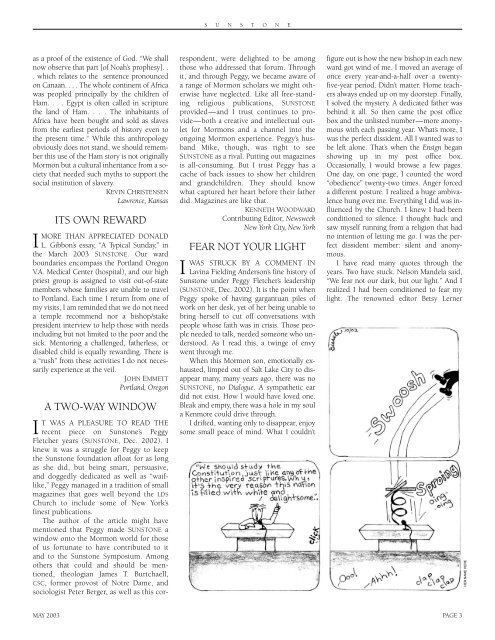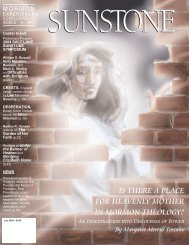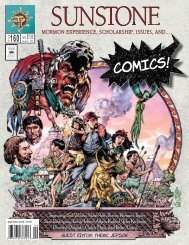the stigma of early return the stigma of early return - Sunstone ...
the stigma of early return the stigma of early return - Sunstone ...
the stigma of early return the stigma of early return - Sunstone ...
You also want an ePaper? Increase the reach of your titles
YUMPU automatically turns print PDFs into web optimized ePapers that Google loves.
S U N S T O N E<br />
as a pro<strong>of</strong> <strong>of</strong> <strong>the</strong> existence <strong>of</strong> God. “We shall<br />
now observe that part [<strong>of</strong> Noah’s prophesy]. .<br />
. which relates to <strong>the</strong> sentence pronounced<br />
on Canaan. . . . The whole continent <strong>of</strong> Africa<br />
was peopled principally by <strong>the</strong> children <strong>of</strong><br />
Ham. . . . Egypt is <strong>of</strong>ten called in scripture<br />
<strong>the</strong> land <strong>of</strong> Ham. . . . The inhabitants <strong>of</strong><br />
Africa have been bought and sold as slaves<br />
from <strong>the</strong> earliest periods <strong>of</strong> history even to<br />
<strong>the</strong> present time.” While this anthropology<br />
obviously does not stand, we should remember<br />
this use <strong>of</strong> <strong>the</strong> Ham story is not originally<br />
Mormon but a cultural inheritance from a society<br />
that needed such myths to support <strong>the</strong><br />
social institution <strong>of</strong> slavery.<br />
KEVIN CHRISTENSEN<br />
Lawrence, Kansas<br />
ITS OWN REWARD<br />
IMORE THAN APPRECIATED DONALD<br />
L. Gibbon’s essay, “A Typical Sunday,” in<br />
<strong>the</strong> March 2003 SUNSTONE. Our ward<br />
boundaries encompass <strong>the</strong> Portland Oregon<br />
V.A. Medical Center (hospital), and our high<br />
priest group is assigned to visit out-<strong>of</strong>-state<br />
members whose families are unable to travel<br />
to Portland. Each time I <strong>return</strong> from one <strong>of</strong><br />
my visits, I am reminded that we do not need<br />
a temple recommend nor a bishop/stake<br />
president interview to help those with needs<br />
including but not limited to <strong>the</strong> poor and <strong>the</strong><br />
sick. Mentoring a challenged, fa<strong>the</strong>rless, or<br />
disabled child is equally rewarding. There is<br />
a “rush” from <strong>the</strong>se activities I do not necessarily<br />
experience at <strong>the</strong> veil.<br />
JOHN EMMETT<br />
Portland, Oregon<br />
A TWO-WAY WINDOW<br />
respondent, were delighted to be among<br />
those who addressed that forum. Through<br />
it, and through Peggy, we became aware <strong>of</strong><br />
a range <strong>of</strong> Mormon scholars we might o<strong>the</strong>rwise<br />
have neglected. Like all free-standing<br />
religious publications, SUNSTONE<br />
provided—and I trust continues to provide—both<br />
a creative and intellectual outlet<br />
for Mormons and a channel into <strong>the</strong><br />
ongoing Mormon experience. Peggy’s husband<br />
Mike, though, was right to see<br />
SUNSTONE as a rival. Putting out magazines<br />
is all-consuming. But I trust Peggy has a<br />
cache <strong>of</strong> back issues to show her children<br />
and grandchildren. They should know<br />
what captured her heart before <strong>the</strong>ir fa<strong>the</strong>r<br />
did. Magazines are like that.<br />
KENNETH WOODWARD<br />
Contributing Editor, Newsweek<br />
New York City, New York<br />
FEAR NOT YOUR LIGHT<br />
I<br />
WAS STRUCK BY A COMMENT IN<br />
Lavina Fielding Anderson’s fine history <strong>of</strong><br />
<strong>Sunstone</strong> under Peggy Fletcher’s leadership<br />
(SUNSTONE, Dec. 2002). It is <strong>the</strong> point when<br />
Peggy spoke <strong>of</strong> having gargantuan piles <strong>of</strong><br />
work on her desk, yet <strong>of</strong> her being unable to<br />
bring herself to cut <strong>of</strong>f conversations with<br />
people whose faith was in crisis. Those people<br />
needed to talk, needed someone who understood.<br />
As I read this, a twinge <strong>of</strong> envy<br />
went through me.<br />
When this Mormon son, emotionally exhausted,<br />
limped out <strong>of</strong> Salt Lake City to disappear<br />
many, many years ago, <strong>the</strong>re was no<br />
SUNSTONE, no Dialogue. A sympa<strong>the</strong>tic ear<br />
did not exist. How I would have loved one.<br />
Bleak and empty, <strong>the</strong>re was a hole in my soul<br />
a Kenmore could drive through.<br />
I drifted, wanting only to disappear, enjoy<br />
some small peace <strong>of</strong> mind. What I couldn’t<br />
IT WAS A PLEASURE TO READ THE<br />
recent piece on <strong>Sunstone</strong>’s Peggy<br />
Fletcher years (SUNSTONE, Dec. 2002). I<br />
knew it was a struggle for Peggy to keep<br />
<strong>the</strong> <strong>Sunstone</strong> foundation afloat for as long<br />
as she did, but being smart, persuasive,<br />
and doggedly dedicated as well as “waiflike,”<br />
Peggy managed in a tradition <strong>of</strong> small<br />
magazines that goes well beyond <strong>the</strong> LDS<br />
Church to include some <strong>of</strong> New York’s<br />
finest publications.<br />
The author <strong>of</strong> <strong>the</strong> article might have<br />
mentioned that Peggy made SUNSTONE a<br />
window onto <strong>the</strong> Mormon world for those<br />
<strong>of</strong> us fortunate to have contributed to it<br />
and to <strong>the</strong> <strong>Sunstone</strong> Symposium. Among<br />
o<strong>the</strong>rs that could and should be mentioned,<br />
<strong>the</strong>ologian James T. Burtchaell,<br />
CSC, former provost <strong>of</strong> Notre Dame, and<br />
sociologist Peter Berger, as well as this corfigure<br />
out is how <strong>the</strong> new bishop in each new<br />
ward got wind <strong>of</strong> me. I moved an average <strong>of</strong><br />
once every year-and-a-half over a twentyfive-year<br />
period. Didn’t matter. Home teachers<br />
always ended up on my doorstep. Finally,<br />
I solved <strong>the</strong> mystery. A dedicated fa<strong>the</strong>r was<br />
behind it all. So <strong>the</strong>n came <strong>the</strong> post <strong>of</strong>fice<br />
box and <strong>the</strong> unlisted number—more anonymous<br />
with each passing year. What’s more, I<br />
was <strong>the</strong> perfect dissident. All I wanted was to<br />
be left alone. That’s when <strong>the</strong> Ensign began<br />
showing up in my post <strong>of</strong>fice box.<br />
Occasionally, I would browse a few pages.<br />
One day, on one page, I counted <strong>the</strong> word<br />
“obedience” twenty-two times. Anger forced<br />
a different posture. I realized a huge ambivalence<br />
hung over me. Everything I did was influenced<br />
by <strong>the</strong> Church. I knew I had been<br />
conditioned to silence. I thought back and<br />
saw myself running from a religion that had<br />
no intention <strong>of</strong> letting me go. I was <strong>the</strong> perfect<br />
dissident member: silent and anonymous.<br />
I have read many quotes through <strong>the</strong><br />
years. Two have stuck. Nelson Mandela said,<br />
“We fear not our dark, but our light.” And I<br />
realized I had been conditioned to fear my<br />
light. The renowned editor Betsy Lerner<br />
HER NAME HERE<br />
MAY 2003 PAGE 3

















